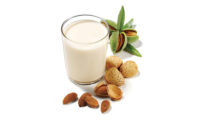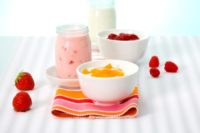In the words of the Academy of Nutrition and Dietetics, “All foods are functional at some physiological level.” Those of us in the dairy business couldn’t agree more, and we’re likely to point to our own category as representative of functional foods par excellence.
But, the Academy continues, “[F]oods that include whole foods and fortified, enriched or enhanced foods have a potentially beneficial effect on health when consumed as part of a varied diet on a regular basis.” And that’s just where the benefits of plain ol’ dairy are eclipsed by the added functional benefits of what we might call “dairy plus.”
These days, “dairy plus” is everywhere, whether in the form of probiotic frozen yogurt, omega-enhanced cheeses or workout-boosting “muscle milks.” By leveraging dairy’s nature-made nutrition with added bioactives and healthful nutrients, functional dairy gives consumers a wellness boost that’s in demand. And the numbers bear this out: According to the Nutrition Business Journal, 2011 functional dairy sales totaled $2.09 billion, amounting to a 7% increase over the prior year.
So what makes a dairy-plus product attractive to health-minded consumers? And how can we make these products “work,” as it were? Functional ingredient suppliers have been asking these questions for years, and they’ve come up with some pretty actionable answers in the process. We asked a few questions to find out what they are thinking.
Dairy Foods: So why is now a great time to be in functional dairy?
Sarah M. Hines, market specialist, dairy, DuPont Nutrition & Health, New Century, Kan.: Consumers naturally look to dairy because of its benefits, such as added vitamins or cultures. Therefore, they aren’t surprised when there are claims on the front of the pack for fortification or added functional benefits. The market is very strong, and since this is a natural place for consumers to look for these benefits, it is growing. Dairy is a relatively mature market, so these product line extensions are where the new growth is coming from.
Dairy Foods: Why is dairy a suitable candidate for delivering functional ingredients?
Todd Sitkowski, senior marketing manager, dairy, DSM Nutritional Products, Parsippany, N.J.: The fact that dairy-based products contain some level of fat, are for the most part packaged in materials that are good oxygen barriers and are refrigerated makes it an ideal vehicle for added nutrition that is stable throughout the shelf life of the product and still tastes great.
Diane Hnat, senior technical marketing manager, DSM Nutritional Products: Customers continue to indicate that their consumers are looking for functional milks and yogurts. The relatively short shelf life in the refrigerated dairy case maintains the fresh image of both the functional ingredients and the finished products. From a supplier’s perspective, adding nutrients to these two categories is readily doable.
Of course, there needs to be due diligence in handling some of these “sensitive” ingredients for optimal results. Longer shelf-life dairy items can also benefit from the addition of functional ingredients; certain other processing or formulating adjustments may be necessary with these, as well.
Dairy Foods: What are consumers looking for from their functional foods, dairy-based or otherwise?
Sitkowski: It really comes down to the demographics of the consumer group. Each of these groups has different condition-specific health concerns and interests, depending on what stage they’re at in their lives.
Mothers are concerned about their children’s continued cognitive development, proper body development and overall health. Women aged 30 to 50 start becoming concerned and aware of their overall bone health and the potential for osteoporosis. Boomers, both men and women, start to become more concerned with their memory, and with retaining mental sharpness — along with a concern over cardiovascular disease amongst the men of this group, in particular.
|
"The addition of vitamin D and calcium to support bone health continues to expand in dairy-based products such as yogurt, processed cheese, cheese sticks and dairy-based snacks." — Todd Sitkowski, DSM Nutritional Products |
Dairy Foods: How do these consumer concerns converge with the rising interest in “positive nutrition,” as well as with that ever-present drive for clean labels?
Hines: Consumers are attaching to positive messaging right now — anything that doesn’t make them embarrassed to put a product into their carts, or that doesn’t make them feel bad for buying it. Consumers want to feel they are eating healthily and not constantly counting calories, fat or points.
Earl Christiansen, senior scientist, Glanbia Nutritionals, Twin Falls, Idaho:Consumers’ interest in understanding what goes into their food continues to grow, with companies benefiting by eliminating unrecognizable or undesired ingredients from their products. In the area of fresh dairy, the elimination of gums, gelatin and stabilizers is leading to increased interest in functional dairy proteins similar to [our] series of milk and whey protein products.
Dairy Foods: Speaking of protein, we’ve been hearing a lot about it as a popular functional ingredient in dairy. Give us the lowdown on high protein.
Hines: Protein is big right now, and this is even bigger when it comes to dairy, especially with the Greek yogurt craze. You are seeing many more companies and products with a protein claim and you’re seeing it in a lot of the diet lines — not just in dairy, but in other segments, as well.
Christiansen: Protein as a desired ingredient continues to grow. With consumers’ increasing desire to intake more protein throughout the day, new applications and formats are being developed by food and beverage companies to deliver higher levels of protein more conveniently.
Dairy Foods: Which proteins should we be targeting for inclusion? That is to say, are all proteins created equal, or are some more nutritionally advantageous than others?
Gwen Bargetzi, director of marketing, Hilmar Ingredients, Hilmar, Calif.: A complete protein contains all the essential amino acids in the amounts needed for good human health. Further, a high-quality protein is not just complete, but is also digestible, so that a sufficient quantity of amino acids reaches the body’s cells to permit them to do their work, producing lean muscle, hormones and enzymes, assisting metabolic processes and promoting other life-sustaining activities.
Dairy Foods: So we know dairy proteins are solid choices, but is there something especially healthful about dairy proteins?
Christiansen: The high content of essential amino acids in dairy proteins provides a number of health benefits and makes them the ideal ingredients for protein enhancement.
Dairy Foods: Give us some ideas of products where we can use protein to target functional benefits to a particular type of consumer, or maybe a particular category of products.
Courtney Kingery, marketing and customer development manager, ADM North American Oilseeds, Decatur, Ill.: Protein has long been a key ingredient in sports recovery beverages, but it is now commonly consumed by athletes of all levels. Today, there are protein-containing beverages in supermarkets, restaurants and smoothie bars. Increased consumer consumption, coupled with a greater variety of protein-fortified beverages, has led to the increased importance of soy proteins.
Christiansen: Sports-oriented consumers are interested in achieving the optimal benefits of branched-chain amino acids and other bioactives.
Kingery: Also, the weight management beverage category continues to expand beyond traditional meal replacement drinks. Consumer demand remains high for low-sugar, high-fiber and high-protein weight management beverages. With this continued trend, beverage brand owners are looking to focus on ways to incorporate proven ingredients, such as soy protein, into their weight management beverages. Studies are finding that low-fat proteins, like soy proteins, have a positive impact on satiety and glycemic response.
Dairy Foods: You mentioned soy proteins. What benefits do they bring beyond what we get from dairy?
Kingery: Isolated soy proteins are the only plant-based proteins that are nutritionally equivalent to animal-sourced proteins. The nutritional properties, availability and clean flavor of [one of our products] make it an excellent choice for manufacturers looking to supplement dairy proteins to help mitigate price fluctuations without impacting quality.
Manufacturers should also consider how isolated soy proteins can work together with whey protein and casein in dairy-based beverages. Because of differences in digestion rates, amino acid profiles and antioxidant activity, a balanced formulation including a mix of isolated soy proteins, whey protein and casein can offer the optimal synergies of taste, function and results.
Dairy Foods: We know all about protein. But that’s not the only functional news going on out there, is it?
Sitkowski: There continues to be building awareness of and interest in EPA [eicosapentaenoic] and DHA [docosahexaenoic] omega-3 fatty acids. A number of functional milk products currently on the market have added DHA omega-3s to support brain health, as do other products with added EPA/DHA omega-3s to support heart health.
The appeal to consumers of these products is that not only is the awareness of the science supporting DHA brain and EPA/DHA heart health strong and well known, but consumption of these essential fatty acids benefits consumers at all life stages, from infants to boomers.
Dairy Foods: What about bone health? That’s a key strength of dairy. In what ways can we enhance it through functional fortification?
Sitkowski: The addition of vitamin D and calcium to support bone health continues to expand in dairy-based products such as yogurt, processed cheese, cheese sticks and dairy-based snacks. Consumers are interested in consuming foods that have added vitamin D and calcium along with other bone-health support nutrients, such as the minerals phosphorus, magnesium and zinc.
Consumers are not only aware of the connection between the intake of vitamin D and calcium to good bone health, but also are beginning to realize that there is a gap between the levels they are getting in their diets and the intake levels that the science behind bone health supports.
Dairy Foods: So all this functional fortification is well and good, but what about formulation? What should we know about how these functional ingredients stand up to use in an actual dairy product and processing environment.
Kingery: When formulating beverages that include protein, alignment of the beverage characteristics with protein functionality is critical for successful formulation. Matching the functional properties of the proteins with the pH of the beverage is critical for proper stability of the proteins.
Isoelectric point is defined as the pH at which the total charge on the protein molecule is equivalent to zero. At this pH, the protein is not soluble, and as a result the protein precipitates out of solution. The use of hydrocolloids such as stabilizers is typically required to keep the protein in solution at or below the isoelectric point. When formulating low-pH beverages with traditional protein, stabilizers are incorporated to prevent separation and to contribute to mouthfeel and viscosity.
Another beverage characteristic to be mindful of is beverage appearance, whether it be transparent or opaque. For neutral and opaque beverage systems such as dairy-based beverages, [an isolated soy protein] is an excellent choice for increasing the protein content without negatively impacting viscosity, and it blends well with proteins from other sources. It’s a clean-tasting isolated soy protein for neutral-pH applications, providing beverage manufacturers the ability to comfortably formulate up to 10 grams of protein into their products.
Christiansen: The growth of the Greek yogurt market to a billion-dollar category in a few short years validates that high-protein products are hot and in demand. Traditional yogurt, kids’ yogurt, breakfast yogurt, Greek yogurt, sour cream — all are enhanced functionally and show improved sensory characteristics by using [milk protein concentrate and whey protein ingredients] in their formulations.
Dairy Foods: Ultimately, what do you see as the best strategy for successfully formulating functional dairy?
Hnat: The key strategy is close communication between ingredient suppliers and manufacturers throughout the development and commercialization steps. It’s great when the marketing team decides to add functional nutrients. It’s most successful when the supplier is able to provide guidance to the team’s R&D and/or plant coordinator regarding best practices in handling, storage and processing. The R&D team also appreciates when the supplier provides assistance on how to analyze for these added ingredients if they are part of the nutrition facts panel and may involve new or unique testing methodologies.
Some suppliers now feature internal “applications lab” or “innovation lab” prototypes as part of their marketing assistance to customers. It’s an appealing addition to a supplier’s presentation and gives a customer’s product developer an early opportunity to ask questions like “What if?” or “Could we use it this way?” Sometimes it may be easy enough to incorporate a functional ingredient into a milk, yogurt, smoothie, et cetera, but additional costs might merit further information on the health-benefit impact to the consumers, and help for the marketing team with sounder product positioning.
Dairy Foods:As you look ahead, what are the most exciting opportunities — and challenges — for the functional dairy category?
Hnat: Customers are asking more about adding functional ingredients to other dairy products, such as cream cheese, processed cheese and cottage cheese. There are more technical challenges with such items. These will require more investment from suppliers to “make them work,” even though the dairy products themselves have more targeted or limited consumption.
Sitkowski: The addition of functional ingredients to individually wrapped cheese products, such as string cheese and cheese sticks, is an emerging product category. With these products mainly being targeted toward kids, this presents an ideal opportunity to fortify these products with added nutrients such as vitamin D and omega-3s that are currently lacking in kids’ diets at this particular life stage.
The challenge with nutrient addition to these products lies not only with making sure that the shelf life requirements for the product are met, but also that the additional cost of adding the nutrients fits with the price consumers are willing to pay. And, of course, as with all product targeted toward kids, the product must taste great, as well.






